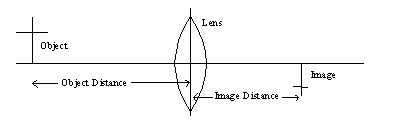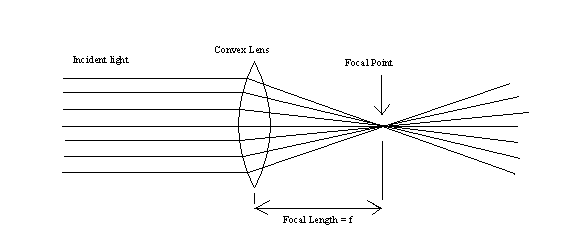Spherical mirrors and lenses Name:________________________
Course:_______________Time:__________________Partners:____________________________
Theory: For a spherical mirror or thin lens the focal length, f is given by (do = object distance, di = image distance);
![]()
Magnification, m is given by the following equations; (Si = image size, So = object size).
![]()
![]()

The object distance is from the object to the lens or mirror and the image distance is from the image to the lens or mirror.
Make a sketch of the following lenses & mirrors below:
| Convex Lens | Concave Lens | Plane Mirror | Concave Mirror | Convex Mirror |
|
|
|
Sign Convention | ||
| Object & Image distances------> | Real--------> (+) | Virtual------> (-) |
| Focal Lengths------------------> | Convex lens & Concave mirror----> (+) | Concave lens & Convex mirror----> (-) |

_____________________________________________________________________________
Physlet Exercises:
Go to the Chap-23,
Giancoli website, and click "Physlet Problems".
A. Concave Mirror: Problems 1, 3, and 4.
1. Start the first problem. In this problem a point source is located left of the concave mirror. Move the source along the axis until the reflected rays are parallel to the axis. At this point the source is located at the focal point. The focal length is the distance from the focal point to the mirror.
X- coordinate of the mirror position = __________
X- coordinate of the focal point = __________
Focal length of the concave mirror = __________
2. Start Problem #3. A parallel beam of light is striking the mirror. By definition, the focal point is the point where parallel beam of light converge after reflecting from the concave mirror.
Move the beam, green oval, and observe what happens to the focal point:
_____________________________________________________
X- coordinate of the mirror position = __________
X- coordinate of the focal point = __________
Focal length of the concave mirror = __________
3. Start Problem #4. An object is placed in front of a concave mirror and the formation of the real image can be seen. Here the object is real, and the image is also real. The focal length can be calculated using the object distance and the image distance.
X- coordinate of the mirror position = __________
X- coordinate of the object position = __________ Object distance = do = ________
X- coordinate of the image position = __________ Image distance = di = _________
Calculated, Focal length of the concave mirror = __________
B. Convex Mirror: Problem 2.
Start Problem #2. An object is placed in front of a convex mirror and the formation of the virtual image can be seen. The image is virtual or non-real here, because, one has to extend the rays to locate the position of the the image. Since the image is virtual, we need to assign a negative sign for the image distance.
X- coordinate of the mirror position = __________
X- coordinate of the object position = __________ Object distance = do = ________
X- coordinate of the image position = __________ Image distance = di = _________
Calculated, Focal length of the convex mirror = __________
C. Convex Lens: Problem 8.
1. Start Problem #8. A light source is located to the left of a lens. Formation of a real image is also shown.
X- coordinate of the middle of the lens position = __________
X- coordinate of the object position = __________ Object distance = do = ________
X- coordinate of the image position = __________ Image distance = di = _________
Calculated, Focal length of the convex lens = __________
2. Click-Drag the lens until the refracted rays are parallel. At this point the source is located at the focal point. Focal length is the distance from the focal point to the lens.
X- coordinate of the middle of the lens position = __________
X- coordinate of the focal point = __________
Focal length of the convex lens = __________
D. Concave Lens: Problem 9.
Start Problem #9. An object is placed to the left of a concave lens and the formation of the virtual image can be seen. The image is virtual or non-real here, because, one has to extend the rays to locate the position of the image. Since the image is virtual, we need to assign a negative sign for the image distance.
X- coordinate of the middle of the lens position = __________
X- coordinate of the object position = __________ Object distance = do = ________
X- coordinate of the image position = __________ Image distance = di = _________
Calculated, Focal length of the concave lens = __________
End of Physlet Exercises___________________________________________________________
A. Purpose: Investigate the difference between a convex lens and a concave lens in forming real images.
Apparatus: Optical bench and accessories, convex lens (f = 5 cm), and concave lens.
Procedure: Set the object & light bulb at the 0 cm end of the bench. Put the convex lens in the lens holder and place it in the optical bench so that the object distance is 5 cm. Move the screen and see whether you get a real image on the screen. Repeat the above procedure for other object distances and the concave lens.
Data:
| Object Distance (cm) | For convex lens, Real image YES/NO | For concave lens, Real image YES/NO |
| 5 | - | - |
| 10 | - | - |
| 15 | - | - |
| 20 | - | - |
| 25 | - | - |
| 30 | - | - |
| 35 | - | - |
| 40 | - | - |
| 45 | - | - |
| 50 | - | - |
| 55 | - | - |
| 60 | - | - |
| 65 | - | - |
| 70 | - | - |
| 75 | - | - |
| 80 | - | - |
| 85 | - | - |
| 90 | - | - |
Conclusion: ____________________________________________________________________
_____________________________________________________________________________
_____________________________________________________________________________
B. Purpose: For convex lenses, investigate and find out the range of object distances for which there are real images, and predict a correlation between the focal length and object distances for real images.
Apparatus: Optical bench and accessories, convex lenses: f = 10 cm, 15 cm, 20 cm, and 30 cm.
Data:
| Object Distance (cm) | f = 10 cm,
Real image YES/NO |
f = 15 cm,
Real image YES/NO |
f = 20 cm,
Real image YES/NO |
f = 30 cm, Real image
YES/NO |
| 5 | - | - | - | - |
| 10 | - | - | - | - |
| 15 | - | - | - | - |
| 20 | - | - | - | - |
| 25 | - | - | - | - |
| 30 | - | - | - | - |
| 35 | - | - | - | - |
| 40 | - | - | - | - |
| 45 | - | - | - | - |
| 50 | - | - | - | - |
| 55 | - | - | - | - |
| 60 | - | - | - | - |
| 65 | - | - | - | - |
| 70 | - | - | - | - |
| 75 | - | - | - | - |
| 80 | - | - | - | - |
| 85 | - | - | - | - |
Conclusion:_____________________________________________________________________
______________________________________________________________________________
______________________________________________________________________________
______________________________________________________________________________
C. Purpose: To investigate the magnifications of real images formed by a convex lens and determine the focal length.
Apparatus: Convex lenses (f = 20 cm), optical bench & accessories, and foot ruler.
Theory: For a thin lens focal length, f is given by (do = object distance, di = image distance);
![]()
Magnification, m is given by the following equations; (Si = image size, So = object size).
![]()
![]()
Procedure: Measure the object size. Place the 20-cm lens in the lens holder and set up the lens holder at 30 cm from the object. Move the screen and obtain a sharp image. Measure the image distance and the image size. Repeat the measurements for other object distances and complete the data table.
DATA: Convex Lens of focal length 20 cm
Object size = so = _____________
| Object distance, do | Image distance, di | Focal length, f | Image size, si | Magnification, |m| = si /so | Magnification, |m| = di /do |
| 30 cm | |||||
| 35 cm | |||||
| 40 cm | |||||
| 45 cm | |||||
| 50 cm | |||||
| 55 cm | |||||
| 60 cm | |||||
| 65 cm |
Conclusion:_____________________________________________________________________
______________________________________________________________________________
______________________________________________________________________________
______________________________________________________________________________
D. Purpose: To investigate the magnifications of real images formed by a concave mirror and determine the focal length.
Apparatus: Concave mirror, optical bench & accessories, and foot ruler.
Theory: For a spherical mirror, focal length, f is given by (do = object distance, di = image distance);
![]()
Magnification, m is given by the following equations; (Si = image size, So = object size).
![]()
![]()
Procedure: Measure the object size. Place the concave mirror in the mirror holder and set up the holder at 35 cm from the object. Move the screen and obtain a sharp image. Measure the image distance and the image size. Repeat the measurements for other object distances and complete the data table.
DATA: Concave mirror
Object size = so = _____________
| Object distance, do | Image distance, di | Focal length, f | Image size, si | Magnification, |m| = si /so | Magnification, | m| = di /do |
| 35 cm | |||||
| 40 cm | |||||
| 45 cm | |||||
| 50 cm | |||||
| 55 cm | |||||
| 60 cm | |||||
| 65 cm | |||||
| 70 cm |
Conclusion:_____________________________________________________________________
______________________________________________________________________________
______________________________________________________________________________
______________________________________________________________________________